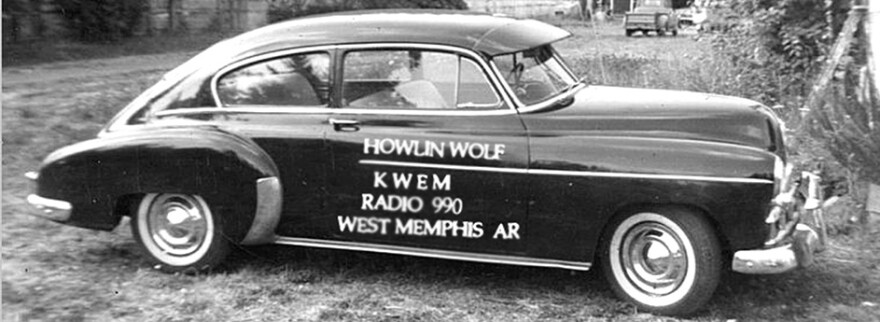Every year more than 10 million visitors come to Memphis, and spend more than three billion dollars, much of it on music-related tourism. But few ever cross the bridge to West Memphis, Arkansas. Now some in the area are trying to change that by capitalizing on the rich musical history of an old West Memphis radio station, KWEM.
In the late 1940s and early 1950s, KWEM was a stepping-stone for musicians on their way to greater fame. The roster of the soon-to-be-famous who graced the station’s airwaves includes Howlin’ Wolf, B.B King, Sonny Boy Williamson, Elvis Presley, and Johnny Cash.
“This is our first time to be coming out your way, by way of radio,” the Man in Black told listeners when he and the Tennessee Two appeared on KWEM in 1955.
At the time, KWEM aired live music and charged performers a fee for a 15 minute slot. Many musicians found sponsors to pay the station’s fee, (Cash was sponsored by Home Equipment Company, where the singer had a day job).
“If you had $25, you got to be on the radio. They [the station] didn’t care,” explained Dale Franklin, a musician who has researched KWEM with a fascination that most people reserve only for their family tree. “It turns out that there were some incredible musicians in the area, and they showed up.”
Performers used these radio appearances as an entrée to a recording contract, and to boost attendance at their stage shows. Before 1955, most Americans didn’t own a television. “So radio was a big deal,” Franklin said.

KWEM aired country music, blues, and gospel. As a teenager, Larry Manuel played in his father’s country music band on the station, and recalls bumping into performers of different genres in the hallways. In particular, Manuel remembers a blues singer who later became legendary for his voice and physical presence.
“One of the black musicians, Howlin’ Wolf, we would pass in the studio hallways and speak. Just, you know, ‘Hello, how you doing?’” Manuel said. “But as far as, you know, having much conversation, I mean, I’m like 13, 14 years old, and he’s a grown man.”
Manuel said his father knew the blues singer a little better. “Now he [Wolf] and dad were acquainted, obviously went back in the 1940s,” Manuel said. “The white musicians and the black musicians they kind of, they blended together in that they were all friendly with each other … something of a community of musicians.”
By 1960, KWEM had stopped playing live music, and eventually went off the air. But it has recently started broadcasting again on the internet, using a space at the Mid-South Community College in West Memphis.
Initially the college experimented with some test broadcasts, and hopes to be airing a 24-hour stream of music in the coming weeks.
At first the stream will feature only pre-recorded music by artists associated with KWEM in the 1940s and 1950s. In future years, college President Glen Fenter hopes to vary that format to create space for experimentation by students, and possibly more of the live performance slots that attracted so many area musicians to KWEM decades ago.
Fenter is hoping all the history at the station will bring some of the tourists who come to see Sun Studios, Graceland, and the Stax Museum every year across the bridge and into West Memphis.
“We’re not nearly as interested in what it can do for the college as we are in what it can do for the community,” Fenter said. “Tourism, interest in things of historic nature, particularly as they relate to music, is a huge industry across the country. So for our community, for Eastern Arkansas, this is an opportunity that the college had a responsibility to help the community maximize.”
To further that goal, Franklin wants to turn the old KWEM studio into a museum. The original building still stands at 231 Broadway Street in West Memphis.
“We’re interested in actually putting the equipment back, and the furniture. So it would look just like it did when B.B. King saw it, or Elvis saw it. And at that point it would be like Sun Studios. There would be tourists coming in to see this, because they’re going to want to see this,” Franklin said on a visit to the site.
Franklin waved his arms around the largely empty space he sees filled with memorabilia and tourists in the coming years, “This is actually where rock ’n’ roll took place, because this is where the blues musicians and the country musicians ran into each other and sort of played off each other,” Franklin said. “What came out the other side was what we now call rock ’n’ roll.”



